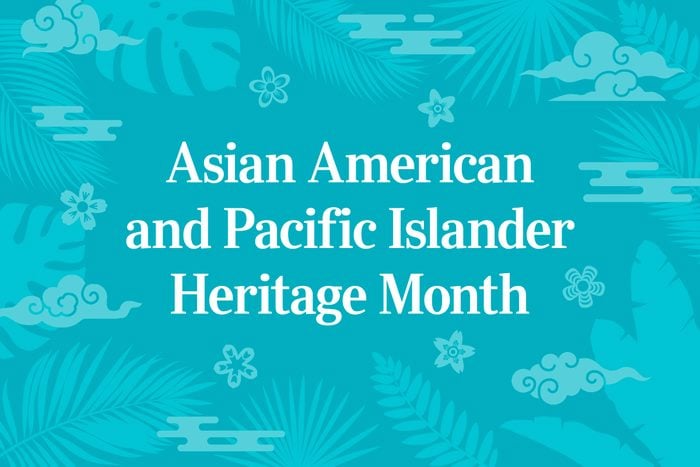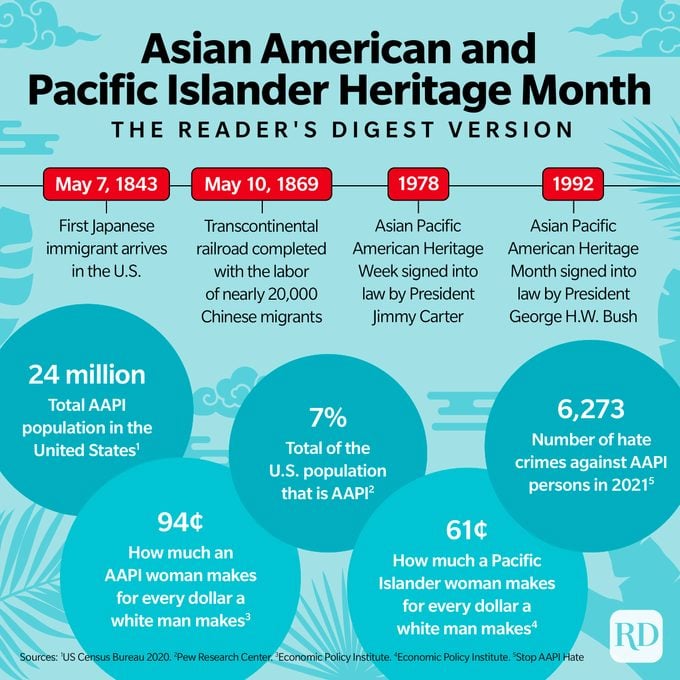What Is Asian American and Pacific Islander Heritage Month—and How Is It Celebrated?
Updated: Feb. 01, 2024

It's more important than ever to honor the many incredible contributions of the Asian American and Pacific Islander community to U.S. history. Read on to learn the rich history of AAPI Heritage Month—and how you can celebrate it in meaningful ways!
With the rise of anti-Asian hate crimes during the coronavirus pandemic, Asian American and Pacific Islander Heritage Month is an especially important time for both celebration and raising awareness. It’s an opportunity to show love and support across the many cultures within the AAPI community as well as solidarity with non-Asian communities—turning grief and injustice into activism and joy. From May 1 to May 31, the nation is reminded that Asian Americans should neither be lumped together into a single East Asian monolith, nor boxed into the stereotype of a model minority to be pitted against other BIPOC communities.
We prove we are worthy of being the main character in mainstream media, including Crazy Rich Asians, Minari, Everything Everywhere All at Once and other AAPI movies; Beef, Never Have I Ever, Squid Games and other AAPI TV shows; and Pachinko, The Magical Language of Others, and other AAPI books; Deep Pacific, Self Evident and other AAPI podcasts. We also recognize the many contributions of activists Philip Vera Cruz, Grace Boggs Lee and Yuri Kochiyama, astronaut Kalpana Chawla, writers Cathy Park Hong and Viet Thanh Nguyen and so many, many more famous Asian Americans.
Even if you’ll be spending May supporting Asian American–owned companies, it’s important to note that being anti-racist is a daily practice, and that we should celebrate diversity all year round. To start, here are some Asian American and Pacific Islander Heritage Month facts you should absolutely know.

What is Asian American and Pacific Islander Heritage Month?
According to the 2020 U.S. Census, there are 24 million—and counting—Asian Americans in the United States, people who trace their roots to East Asia, South Asia, Southeast Asia, Polynesia, Micronesia and Melanesia. The Pew Research Center found that Asians are the fastest-growing ethnic group, making up about seven percent of the total U.S. population. However, it’s precisely because that number is so small that many Asian Americans are deemed “invisible,” with many politicians skipping over the Asian American voter base altogether, and many AAPI issues swept under the rug. From May 1 to May 31, Asian American and Pacific Islander Heritage Month calls attention to these issues, while recognizing and celebrating the contributions of Asian Americans and Pacific Islanders to American history, asserting that we are not perpetual foreigners, but rather Americans in our own right.
Why is AAPI month in May?
Perhaps one of the most interesting Asian American and Pacific Islander Heritage Month facts is why it’s in May. The month was specifically chosen to commemorate the first Japanese immigrant to arrive in the U.S. on May 7, 1843, as well as the completion of the transcontinental railroad on May 10, 1869. The railroad, which opened up the West Coast to expansion, is intertwined with the AAPI community because nearly 20,000 Chinese laborers worked in hazardous, even deadly, conditions for low wages to construct it. AAPI Heritage Month honors the contribution of these Chinese migrants and acknowledges their labor and sacrifice.
What is the history of AAPI month?
It’s important to acknowledge that it was African American Civil Rights activists who paved the way for the Asian American social movement in the 1960s and 1970s, and the eventual demand for AAPI Heritage Month. The umbrella term “Asian American” was not even widely adopted until the ’60s, when different Asian ethnic groups banded together in solidarity.
The idea of honoring Asian Pacific Americans was first introduced in the late 1970s by Capitol Hill staffer Jeanie Jew, whose great-grandfather was a laborer on the transcontinental railroad and was later murdered during a period of anti-Chinese sentiment in the 19th century. She pitched an Asian heritage celebration to New York Congressman Frank Horton, who then introduced it to Congress, while Senator Daniel Inouye introduced a similar idea to the Senate. Asian Pacific American Heritage Week was signed into law in 1978 by President Jimmy Carter, and it was eventually extended to a month and signed into law by President George H.W. Bush in 1992.
Why do we need an AAPI month?
Asian American and Pacific Islander Heritage Month is especially important given the long history of anti-Asian racism and xenophobia in the U.S., starting with the Page Act of 1875, which, among other things, specifically banned Chinese women from entering the country because they were assumed to be prostitutes. Then came the notorious Chinese Exclusion Act of 1882, which essentially banned all Chinese immigrants (not coincidentally after Chinese laborers finished the transcontinental railroad). These were followed by the Gentleman’s Agreement of 1907, which restricted Japanese immigration to the U.S., and the 1924 Asian Exclusion Act, which restricted any Asian immigration until the 1960s. Of course, we can never forget the dehumanization of displacing and confining American citizens to Japanese internment camps during World War II.
The parallels between the anti-Asian sentiment during Jeanie Jew’s great-grandfather’s time and the “China virus” hate crimes are chilling. However, racism and discrimination also appear in insidious ways, like the bamboo ceiling where Asian Americans are often excluded from leadership positions due to the stereotype that we are subservient and unassertive, as well as the daily racial microaggressions many of us endure. This takes a massive toll on Asian American mental health, so while AAPI Heritage month is an opportunity to raise awareness and teach the general public about this dark history, it is also a much-needed time of celebration, to instill pride in one’s heritage.
How to celebrate AAPI Month
Now that we’ve learned some fascinating Asian American and Pacific Islander Heritage Month facts, the question is how to celebrate it! You can continue learning by watching Asian Americans, a five-part documentary series from PBS. Additionally, you can support Asian American businesses and, if you can, donate to Asian American nonprofit organizations like Stop AAPI Hate and National Asian Pacific American Women’s Forum. Many streaming sites like Netflix and Disney+ have their own lists of must-watch Asian American films and TV series, but if you prefer in-person events, seek out local AAPI festivals and events near you.
Sources:
- U.S. Census Bureau: “2020 Census Illuminates Racial and Ethnic Composition of the Country”
- PEW Research Center: “Key facts about Asian Americans, a diverse and growing population”
- Congressional Record: “Asian/Pacific-American Heritage Month (House of Representatives – October 04, 1992)”
